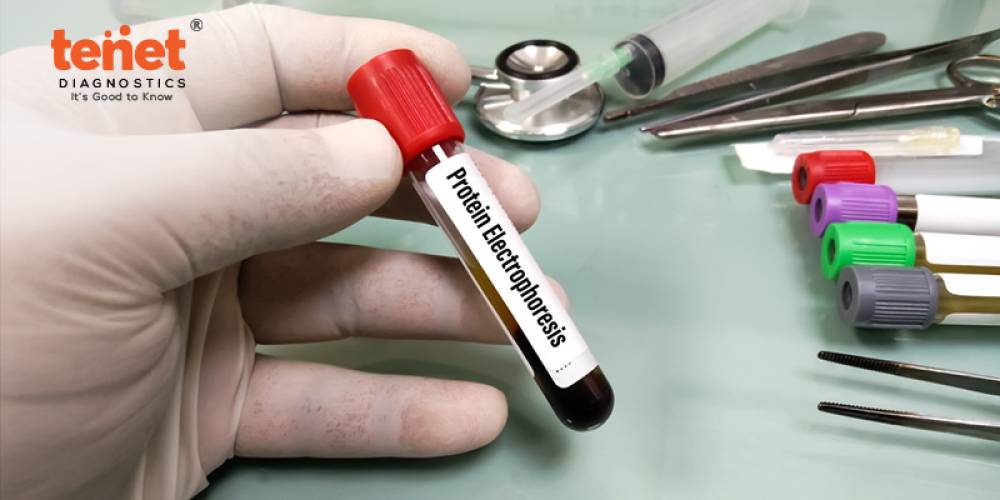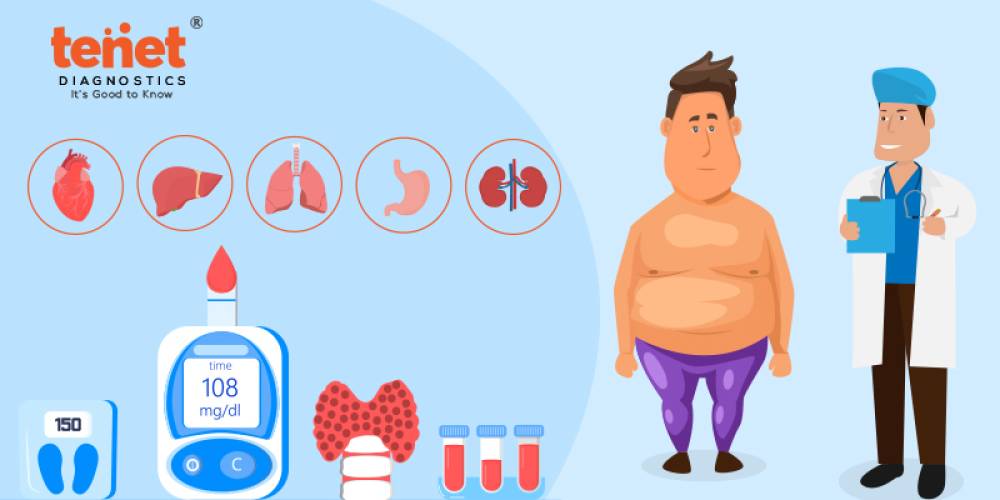Diabetes is a chronic ailment spreading like wildfire that has raised pressing global health concerns. It is alarming to see that more than half a billion people are living with diabetes in the world; there is no bar for age and gender. Surveys projected the likelihood of diabetes cases reaching the 1.3 billion mark in the next 30 years. And it doesn’t end here. Nearly 12.3% of all US adults with diabetes started using insulin within a year of their diagnosis. Possibly, undiagnosed cases are approximately 22.8% of adults, equivalent to 8.7 million people (about half the population of New York). Diabetes shouldn’t be ignored as it functions like a silent killer if left unchecked and can severely damage other healthy organs. Therefore, early detection with a diabetic profile test is strongly recommended.
Diabetic Profile Test – a Brief Overview
Diabetes is a metabolic disorder characterized by elevated blood sugar levels surpassing the normal reference range. Typically, diagnosis involves measuring fasting and post-meal glucose levels. Additionally, glycated hemoglobin (HbA1c) is assessed to estimate the average sugar levels over three months. For individuals diagnosed with type 2 diabetes, supplementary tests are conducted, as heightened glucose levels can impact other systems, such as the heart and kidneys. The diabetic profile test encompasses a comprehensive set of four tests frequently administered to diabetic patients, offering insights into the disease's impact on various bodily systems. This diagnostic test for diabetes is designed to oversee blood sugar levels and maintain a balanced assessment of overall bodily functions. Tests play a crucial role in comprehensive diabetic care, encompassing key elements such as lipid profile, liver function tests, iron deficiency profile, kidney profile, thyroid function tests, and electrolytes, in addition to diabetic screening. Timely identification is essential in mitigating risks associated with both Type 1 and Type 2 diabetes. Through proper diagnosis and treatment, diabetic patients can actively pursue a healthy life. A basic diabetes screening test, which is different from the diagnosis test, is initially conducted to pinpoint individuals at high risk of diabetes, including those without evident symptoms. The diagnosis test, on the other hand, is designed for individuals already exhibiting prominent symptoms. That said, understanding the different types of diabetes will give you enough clarity about the depth of your ailment. On that note, let's talk about the different types.
Types of Diabetes Diagnostic Tests to Consider
Blood sugar testing, screening, and diabetic profile tests are conducted to determine your diabetes type: prediabetes, type 1, type 2, or gestational diabetes. The process is straightforward, and the diabetes test results are typically promptly accessible. Your healthcare provider will administer one or more blood tests to validate the diagnosis.
A1C Test
The A1C test assesses your average blood sugar levels for the preceding 2 or 3 months. A normal A1C is below 5.7%, a range of 5.7 to 6.4% suggests prediabetes, and a reading of 6.5% or higher indicates diabetes.
Fasting Blood Sugar Test
This test evaluates your blood sugar levels after an overnight fast. A fasting blood sugar level within 99 mg/dL or below is considered normal, while a range of 100 to 125 mg/dL suggests prediabetes, and a reading of 126 mg/dL or higher indicates diabetes.
Glucose Tolerance Test
This test assesses your blood sugar levels before and after consuming a glucose-containing liquid. Prior to the test, you'll undergo an overnight fast, and your fasting blood sugar level will be determined through a blood draw. Subsequently, you'll consume the liquid, and your blood sugar levels will be checked at 1 hour, 2 hours, and potentially 3 hours afterward. A blood sugar level of 140 mg/dL or below at the 2-hour mark is considered normal, while a range of 140 to 199 mg/dL suggests prediabetes, and a reading of 200 mg/dL or higher indicates diabetes.
Random Blood Sugar Test
This test measures your current blood sugar levels without the requirement for fasting. It can be conducted at any time. A blood sugar level of 200 mg/dL or higher suggests diabetes. If your physician suspects type 1 diabetes, your blood may be examined for autoantibodies, indicators of the body attacking itself commonly found in type 1 diabetes but not in type 2. Additionally, a urine test may be performed to detect ketones, produced when the body burns fat for energy, helping distinguish between type 1 and type 2 diabetes.
Tests for Gestational Diabetes
The diagnosis of gestational diabetes involves blood tests typically conducted between 24 and 28 weeks of pregnancy. If your risk factors for gestational diabetes are elevated, your doctor might recommend testing at an earlier stage. Elevated blood sugar levels in the early stages of pregnancy may suggest the presence of type 1 or type 2 diabetes rather than gestational diabetes.
Glucose Screening Test
This test evaluates your immediate blood sugar levels. After consuming a glucose-containing liquid, your blood will be drawn 1 hour later to assess your blood sugar level. A normal result is 140 mg/dL or lower. If your level exceeds 140 mg/dL, a glucose tolerance test will be recommended.
Glucose Tolerance Test
This test assesses your blood sugar levels both before and after consuming a glucose-containing liquid. Before the test, you'll undergo an overnight fast, during which your fasting blood sugar level will be determined through a blood draw. Subsequently, you'll consume the liquid, and your blood sugar levels will be checked at 1 hour, 2 hours, and potentially 3 hours afterward. The interpretation of results may vary based on factors such as the glucose drink size and testing frequency. It's advisable to consult with your doctor to understand the significance of your test results. Ideally, the diabetic profile test price in Hyderabad is approximately 679 in Indian currency. So, get your tests done as soon as possible to protect your health against the long-term side effects of diabetes.
Underlying The Long-Term Impact of Diabetes
Even though gestational diabetes is temporary, the other more prominent and permanent versions could potentially damage your organs beyond possible remediation. Elevated blood sugar levels, a characteristic of diabetes, can lead to various complications in your body over time. Prolonged exposure to excess sugar in the blood may adversely affect your eyes, kidneys, nerves, skin, heart, and blood vessels. Therefore, the early signs shouldn’t be ignored, and a prompt diabetic profile test can help you on the road to gradual recovery. That said, type 1 and type 2 diabetes are non-curable. However, timely diagnosis and adequate treatment can prevent them from causing further harm to your overall health and well-being. Here’s a brief overview of the potential side effects to expect from diabetes.
Eye Problems
- Difficulty seeing, especially at night
- Sensitivity to light
- Risk of blindness
Foot and Skin Complications
- Development of sores and infections
- Potential need for amputation of toes, foot, or leg if untreated
- Pain, itching, or oozing in feet, legs, and other areas
Cardiovascular Issues
- Difficulty controlling blood pressure and cholesterol due to diabetes
- Increased risk of heart attack, stroke, and blood vessel problems
- Impaired blood flow to legs and feet
Nerve Damage
- Damaged nerves leading to pain, burning, tingling, and loss of feeling
- Potential impact on erectile function in men
Digestive Problems
- Difficulty digesting food
- Trouble with bowel movements, including constipation or looser, watery movements
Kidney Damage
- High blood sugar and other issues contributing to kidney damage
- Reduced kidney function, potential need for dialysis or transplant
Weakened Immune System
- Diabetes-related weakening of the immune system
- Increased susceptibility to serious complications from common infections
Mental Health
- Association between diabetes and depression
Women's Health
- Irregular menstrual periods and fertility issues in some women with diabetes
Increased Risk Factors
- Higher risk for dementia and bone diseases, including osteoporosis
Low Blood Sugar and Heart Disease
Low blood sugar (hypoglycemia) from diabetes treatment increasing the risk of heart disease As stated before, the signs and risks vary depending on the type of diabetes. It is paramount for you to evaluate your diabetic kind and learn to identify the common symptoms. Please search for the best diagnostic center near me and get tested for diabetes immediately.
A Comprehensive Overview - Diabetes Types, Signs and Symptoms
Diabetes can trigger many other health complications, from milder to severe. Therefore, doctors prescribe a regular health assessment to evaluate your overall health condition. The preliminary screen tests serve the same purpose – awaking you of possible chances. An increase in blood sugar levels is the primary reason for diabetes but the ultimate cause of the ailment varies by type. Typically, there are type 1 and type 2 diabetes. But there are other types as well, such as prediabetes and gestational diabetes, which are potentially reversible. Prediabetes occurs when blood sugar levels exceed the normal range but are not elevated to the extent of being classified as diabetes. Without preventive measures, prediabetes may progress to diabetes. Gestational diabetes occurs during pregnancy and may resolve after childbirth. However, the symptoms also vary depending on the severity of the blood sugar levels. Certain individuals, particularly those with prediabetes, gestational diabetes, or type 2 diabetes, might not exhibit noticeable symptoms. Conversely, type 1 diabetes typically manifests symptoms rapidly and with greater severity. The following list includes the common symptoms of type 1 and 2 diabetes:
- Feeling more thirsty than usual
- Urinating often
- Rapid weight loss
- Feeling tired and weak
- Rapid mood swings
- Blurry vision
- Slow-healing sores
- Prone to infections, such as gum, skin and vaginal infections
Furthermore, the presence of ketones in the urine can cause diabetes. It is a byproduct of the breakdown of muscle and fat during insufficient insulin in the blood.
The Final Takeaway
Diabetes is a chronic disease and requires a consistent approach from the patient regarding timely testing, medication, treatment, and a healthy lifestyle. Diabetic profile tests, screening, and other blood tests are conducted to evaluate your blood sugar levels effectively. Regardless of how severe symptoms and health risks might be, an initial diagnosis and prompt remediation can save your life. You can mitigate the long-term effects of diabetes by maintaining blood pressure, blood glucose, and cholesterol levels within the recommended range. Adopting a healthy lifestyle, including maintaining a healthy weight, making nutritious food choices, limiting alcohol consumption, and refraining from smoking, can further contribute to risk reduction. There’s one important thing to remember: Frequent check-ups and screenings are crucial to identifying any potential issues at an early stage. Regular monitoring ensures timely intervention and proactive management of your health.
Frequently Asked Questions?
Q1: How to take diabetes test
Ans. Monitor blood sugar with a finger-prick test or use a flash glucose monitor/CGM.
Q2. How to test for diabetes
Ans. Random blood glucose tests, like the finger-prick test or the venous blood test, will give you prompt results in a few days.
Q3. How to dispose of diabetic test strips
Ans. Adhere strictly to the disposal instructions inside the test strip package for safe disposal of diabetic test strips.
Q4. What test is used to diagnose diabetes
Ans. The primary blood test for diagnosing diabetes is the HbA1c test, measuring average blood sugar levels over the past two to three months.
Q5. How to detect diabetes without blood test
Ans. A CGM is a meter that doesn't need a blood sample; it typically measures glucose through interstitial fluids in skin tissues.







